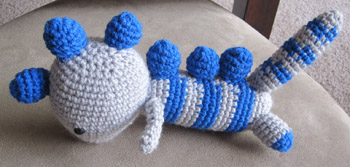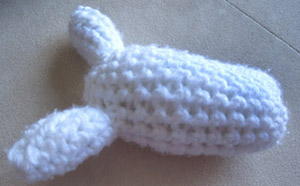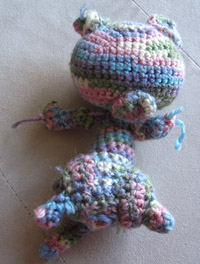Amigurumi Tips and Tricks
By A Guest Writer – 14 CommentsA Guest Post by Ivory Herman.
So you’ve found these super cute crocheted stuffed creations called “amigurumiâ€, fell in love with them, and have stuffed your house full of them with intentions of finding “homes†for all of them? Has this obsession lead you to the internet to search for tips and tricks to make your creation look nice and spiffy? Perhaps this is just something that I do; however, I would like to share a little of what I have learned when making these super cute creations.
Sewing limbs and pieces onto an amigurumi can make for much frustration. This was a very frustrating thing to me, especially when I sew a leg on and it can be mistaken for a tail because of where I sewed it. Or when you have several individual pieces, like in the picture of the dinosaur that I made for my son! As you can see, none of the scales are evenly spaced.

Then one day, I discovered straight pins, and wondered why in the world I hadn’t thought of this earlier! You can get these from any store, even grocery stores. Before you sew a piece onto your creation, pin it up, look at it, and if it’s awkward, just move it around and then sew it on. While you’re sewing, remove the pins as you sew so that way they will keep your piece in place while you’re attaching it to the body of your work.
Big hook, little hook!? Once, I finished an amigurumi and found that I could see what I stuffed it with (as seen in the picture). I guess I had this notion in my head that I had to stick with the recommended hook size, which lead to me being able to see the insides of my piece. The simple solution is to use a smaller hook size, which will leave less space between stitches. Amigurumi are pretty much forgiving in what hook size you use.

| A loose leg, arm, and/or ear! Meet my blind kitty, the very first amigurumi I crocheted. As you can tell, almost all of the ends are loose, and the arms are even falling off! When I made this amigurumi, I left ends that were too short to stay tucked in and as a result, they would slip back up through the stitches. Always leave at least 2-3 inches of a tail, that way you can have enough of an end to keep it hidden. Another method to keep the tails from slipping out is to not shove them through the stuffing first, but weave them under a row of stitches and then tuck the end into the stuffing. This will provide your ends with an anchor to hold onto when the object is being played with. |  |
A wonderful array of colors. When I have an amigurumi that has stripes in it, I would usually cut color A and leave the end inside the work, then go on with color B. Unfortunately this would sometimes leave a hole in the work. What I found that works really well is not cutting color A, but leaving it uncut, until you need it again. That way you can just pick it up and drop the color you don’t need. All you have to do is pull color A tight so you don’t have a really loose stitch.
What to do when putting your work down. So it’s 2am in the morning and you have finally forced yourself to put your work down for the night; however, like me you’re afraid that your work will be torn out by accident? Get a stitch marker that is lockable, pull on the yarn of your last stitch so the loop is fairly sizeable, and lock that stitch marker to that loop. Then you can pull your loop tight and not have to worry about losing stitches in your work.
Hopefully these tips and tricks will help save you time and frustration. Please feel free to share what tips or tricks you have in a comment below.
Ivory has been crocheting for around four years. The things Ivory likes to crochet most are amigurumi and dishcloths, but she is always up for challenging herself with new projects. Besides crochet, she is a mother to a one year old boy and a stay at home mom with a degree in Psychology. To learn more about Ivory visit her blog xX The Catalope Blogs Xx.


Thanks for the tips! They are very helpful, especially the one about using straight pins. I never thought to do that, and my stuff always turn out not straight.
Thanks so much for the tips, they will come in very handy for me. I am SERIOUSLY ADDICTED to amigurumi. The best tip is the one about the straight pins, my stuff never really looks so good when sewing them together.
I’ve only been crocheting since the middle of March but OMG!
(Instant cuteness addiction 🙂
But that first project I “completed” all the pieces and was left staring at a pile of body parts…daunting!!! I leave ends and especially like to tack down the head in a couple of places to make sure it’s in the right spot and help hold it steady before too much sewing would be harder to pick out.
I’ve worked my way through many free patterns – a lot of the time based on a new technique that might add to my progress of learning to crochet. I’m just finishing a bunny doll from my first purchased pattern that actually sews the arms & ears into place as you work down from the top of the head. Was a little scary at first and I was afraid they would get in the way but it wasn’t so bad. I’m surprised more patterns don’t work more of the construction in as you go.
Laurie – I think I like those kind of patterns the best! I just like to see progress made on my project.
They sure can be addicting.. If you have nobody to make them for, go to Yahoo Groups and find a swapper group. I get handmade items from people all over.. it’s nice.
I’ve tried straight pins but I can never get them to stay on, especially when I start trying to sew the pieces on. I must be doing something wrong?
I use safety pins. They stay in place and don’t poke me as I crochet. =D
The safety pins are actually a really good idea. I made a Totoro that kind of went wrong with I was sewing it together, so I think I’ll try again using safety pins.
I try to scale the pin size with my project size: small amigurumi, small sized pins — larger afghan, larger pins. My mother uses the straight pins and never gets stuck by them, I on the otherhand, always get poked no matter how careful I am (hehe).
Good luck!
I just started crocheting earlier this year and am hung up on little critters such as above and have experienced similar “puzzlements.” You have given me solutions – THANK YOU!!!
Helen
Thank you for this article -boy, I wish I had read it before I made “Hello Kitties” last year. My hands are still healing from stuffing and sewing. I punched holes in my fingers a lot!
I’m going to print this out and put it in my Amigarumi patterns file.
Thanks again.
Jeannie
I realize this is a old post, but it has been very helpful to me. I do have a question. What type of yarn do you use? I have been crocheting 6 months, and have recently discovered amigurumis, and I love them. I have made 1, a batman, my grandson plays with it. It is out of Red heart supersaver, and immediately it was fuzzy. I have read where some people say 100n% cotton. I made dishcloths from peachesn creamm and lily something or other, and the red faded onto other items. So I am wondering how it can be used/ My grandchildren are small and the items will be played with and washed.
Thank you very much
Hi Jeannie! Sorry for the late reply. For amigurumi and other stuffed animals/toys, I like to use acrylic yarn. I’ve used Red Heart, Lion brand, Caron, and some store brands. Cotton is nice, but its colors seem to fade easier. If you’d like, you can make small swatches or maybe small toys like this ball ( http://www.crochetspot.com/how-to-crochet-a-sphere/ ) with different brands of yarn and see which holds up best for you. I think that would be a fun experiment!
I use all types of yarn – usually what’s recommended in the patterns although I have switched from time to time if I didn’t have what was suggested. As far as the cottons, I’ve not had any problems with color bleeding but I wash everything except whites in Cold water; Amigurumi things I wash per the fiber instructions and tumble dry on a LOW setting to help prevent shrinkage/fuzziness. Hope that helps some … Good Luck!
Rachel Ty for your reply. I gain so much knowledge from you. You are a wonderful artisit and I appreciate all the sharing you do to help others.